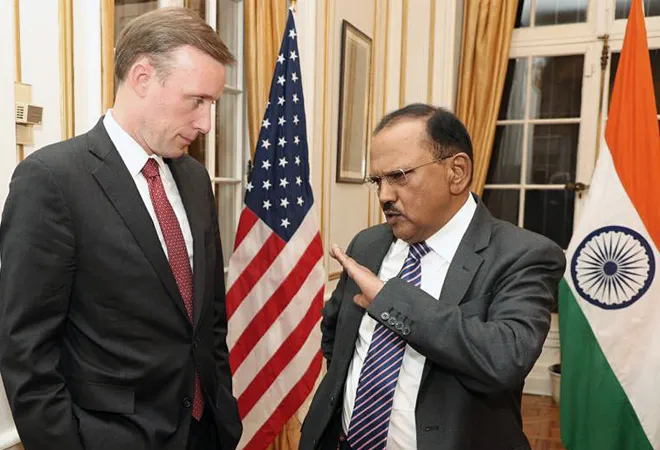
On 7 May, Jake Sullivan, the National Security Advisor, United States (US)
held a meeting with Saudi Arabia's Prime Minister and Crown Prince, Mohammed bin Salman, Sheikh Tahnoon bin Zayed Al Nahyan; the National Security Advisor of the United Arab Emirates (UAE); and Ajit Doval, the National Security Advisor of India. While on its face it may seem to be yet another miniliteral formulation in a rapidly realigning regional and international space, it potentially underscores a US recalibration in the region and is part of a broader policy shift under the Biden administration. In a recent policy
speech, US National Security Advisor Jake Sullivan outlined five pillars of this readjustment underway; partnerships, deterrence, diplomacy and de-escalation, integration, and values. There seems to be, however, a gradation of choice among these principles with the US harping on partnerships and integration. Deterrence remains credibly in place with respect to specific threats only, while concerns with respect to values may have been trumped by geopolitics in the region, at least for the moment.
Deterrence remains credibly in place with respect to specific threats only, while concerns with respect to values may have been trumped by geopolitics in the region, at least for the moment.
There is a resurgent US strategy in West Asia (Middle East) which seeks to break new grounds in the region. This new approach to the region may have been compelled because of several factors. The cold-shouldering of Saudi Arabia by a principled stand on human rights failed to yield desired results for Washington. In the recent past, countries in the Middle East have unexpectedly seen a slew of diplomatic measures to normalise hostile relationships between them, including the much-hyped Saudi-Iran deal brokered by China. A growing space for China in the region and a post-Afghan withdrawal may have compelled a renewed US strategy in the region which focuses on strengthening its periphery around Afghanistan in the region and repositioning itself in an increasingly nuanced matrix of alliances and partnerships that are developing in the region. And if this is the thinking, it also feeds into a sense of urgency in the region to keep the US strategically engaged as well. Regionally, it seeks to rewire US’ relations with key players like Saudi Arabia and UAE, alongside a strong relationship with Israel. The fulcrum of US regional deterrence strategy still remains pivoted on Israel but a gradual diversification of its other pillars of focus comes with the necessity to create space for leverage in a fast-changing region.
A fundamental element of the US Middle East policy, as outlined in the aforementioned speech, is to “connect South Asia to the Middle East to the United States” in ways that advance common economic technological and diplomatic interests. A well-integrated Middle East with South Asia rides on the need to draw a hitherto asymmetrically continental outlook into the Indo-Pacific. This could redistribute the interests of important countries in the Middle East across the Indo-Pacific expanse, creating a much more widely dispersed rationale for a free and open Indo-Pacific. In the long run, a fusion of interests of the Middle East with India and the Indo-Pacific could eat into the strategic space of Beijing and challenge the latter’s repositioning.
A well-integrated Middle East with South Asia rides on the need to draw a hitherto asymmetrically continental outlook into the Indo-Pacific.
However, the fact that this new forum of engagement is outside the direct ambit of the
I2U2 (India-Israel-US-UAE) highlights the fact that a Saudi–Israel normalisation may not be on the cards despite being a major foreign policy aim of Israel’s Prime Minister Benjamin Netanyahu. Regional geopolitics in the Middle East remain fragile, with tensions regarding Iran and its nuclear programme largely unresolved, along with questions over the sustainability and viability of the traditional security architecture provided by the US. Max Boot, a senior fellow at the Council for Foreign Relations, recently
opined that the likes of Saudi Arabia and the UAE are increasingly concluding that US military power in the region is increasingly becoming “ornamental” and not practical. This view is also commonly found across the Arab Gulf, specifically when it comes to President Joe Biden’s White House.
The now visible hedge towards China, as seen during President Xi Jinping’s celebrated visit to the region in December 2022, is not absolute for the Arab monarchies. It is wiser to see this from two major fronts. First, the basic fact that China is a large economy and ignoring that market is currently not an option for almost anyone, including the US. Second, such a hedge feeds into a non-partisan and increasingly influential anti-China lobby in the US which crosses party lines in agreeing towards more hardened measures against Beijing. A perceived drift of traditional US partners in the region may push the Biden administration and its successor to meet Riyadh halfway in ironing out the differences that have ballooned since the killing of journalist and The Washington Post columnist Jamal Khashoggi in Türkiye in 2018, which the US blamed on Crown Prince Mohammed bin Salman’s actions.
The basic fact that China is a large economy and ignoring that market is currently not an option for almost anyone, including the US.
Fundamentally, the I2U2 and now its sistership that binds Saudi Arabia will have an open field to converge on in the future when geopolitical decisions align enough. Recent political upheaval in Israel, for example, created tensions between Arab neighbours and Israel once again with Riyadh and Abu Dhabi, with UAE, its I2U2 and Abraham Accords partner, condemning Israeli actions on Al-Aqsa Mosque which led to Netanyahu’s scheduled and
much-hyped visit to the UAE being shelved. Nonetheless, open diplomatic channels that previously did not exist do work in favour of both, political and economic stability across the region.
India’s inclusion in yet another Quad-like grouping in the region after the I2U2 highlights as much the growing role of India in the Indo-Pacific, as Washington’s own urgency to lay the groundwork for a regional architecture in the Indo-Pacific. Unlike the past when the US practised a regional policy guided by overt geopolitics, Washington’s renewed approach to the Middle East could well be poised to balance regional sensitivities, economic concerns, and multilateralism much more effectively this time.
From New Delhi’s perspective, these minilaterals in the Middle East offer wider geopolitical and geoeconomic connections with one of its most critical partner geographies. The I2U2, from this perspective, is arguably in a good position to develop a first blueprint on how these relatively newer and nimbler diplomacy architectures can deliver tangibly. This is a critical process, as it raises questions for all partner states about mobilising significant financial resources and deploying diplomatic, political, and economic regulatory capacities in a significant way. A blueprint for successfully moving talk shops to workshops is a critical need of the hour.
Kabir Taneja is a Fellow with the Strategic Studies programme at ORF.
Vivek Mishra is a Fellow with the Strategic Studies Programme at ORF.
The views expressed above belong to the author(s). ORF research and analyses now available on Telegram! Click here to access our curated content — blogs, longforms and interviews.



 On 7 May, Jake Sullivan, the National Security Advisor, United States (US)
On 7 May, Jake Sullivan, the National Security Advisor, United States (US)  PREV
PREV



